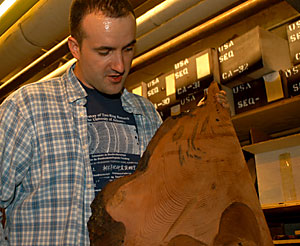 |
|
CLAIRE C. LAURENCE/Arizona Daily Wildcat
|
Dendroarcheologist and research specialist Dr. David Street explains the morphological signs of re-growth on a sample taken from a burned Sequoia tree. The tree ring lab will be moving to a new space after being stationed underneath the Arizona Stadium for over 50 years.
|
|
|
By Zach Colick
Arizona Daily Wildcat
Tuesday, April 6, 2004
Print this
Lab's new home opens in 2006
The largest tree-ring research lab in the country will be uprooted from its home in Arizona Stadium and transplanted to a new location by 2006.
The UA's Laboratory of Tree-Ring Research, which has called the stadium home for the past 67 years, will move to the Environment and Natural Resources building two, which will be situated beside the Dennis DeConcini Environmental and Natural Resources building on North Park Avenue near East Sixth Street.
In the new space, the UA and the United States Geological Survey will collaborate to form the Earth Surface Processes Research Institute, which should bring about 100 new jobs to campus by the time the building is completed in 2006, said John Sutter, chief scientist of the USGS Western Region Earth Surface Processes Team.
Jeff Dean, professor of anthropology and dendrochronology for the tree-ring research lab, said the new modern facilities would also consolidate the facility, which is split between the stadium and the other at the Mathematics East building.
The laboratory analyzes tree rings through dendrochronology, which measures climate changes by studying tree ring growth.
But if the move didn't occur, Dean said the stadium facility has more than enough space to house the massive amounts of tree-ring samples already in storage.
"The advantage of this place is that it has room for storage probably in excess of the millions that you wouldn't get anywhere else," Dean said. "The ceilings won't be 30 feet high like it is here."
The new building for tree-ring research and its partnership with the USGS should help forge a strong relationship between the UA and USGS, Sutter said.
"I think it's going to be an excellent relationship and I'm proud that the UA is looking to build great research opportunities," said Stephanie Hanna, chief of communications for the USGS Western region.
Dean said the department of archaeology has been able to study more tree-ring samples at the laboratory by way of department advancement in resources over the years.
In the 1970s, the archeological department at the laboratory could analyze 1,000 tree-ring samples per year, while today it manages to analyze more than 5,000 tree-ring samples annually, Dean said.
The Environment and Natural Resources building two, part of a complex that is eventually expected to include two more buildings, will also be home to the Institute for the Study of Planet Earth, the Office of Arid Land Studies and the Geosciences and Hydrology and Water Resources departments, Sutter said.

